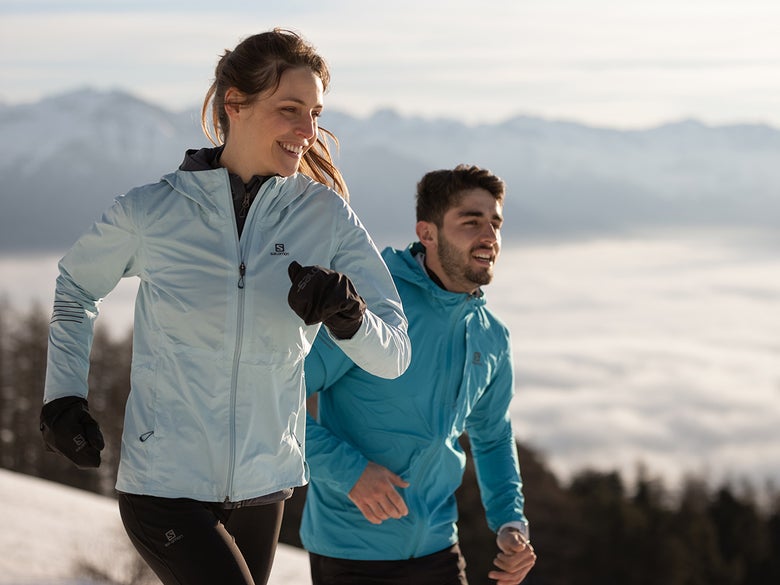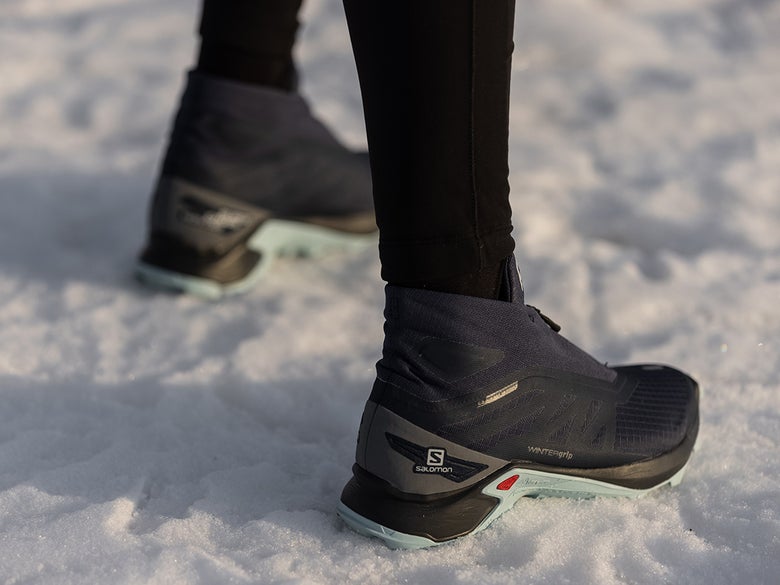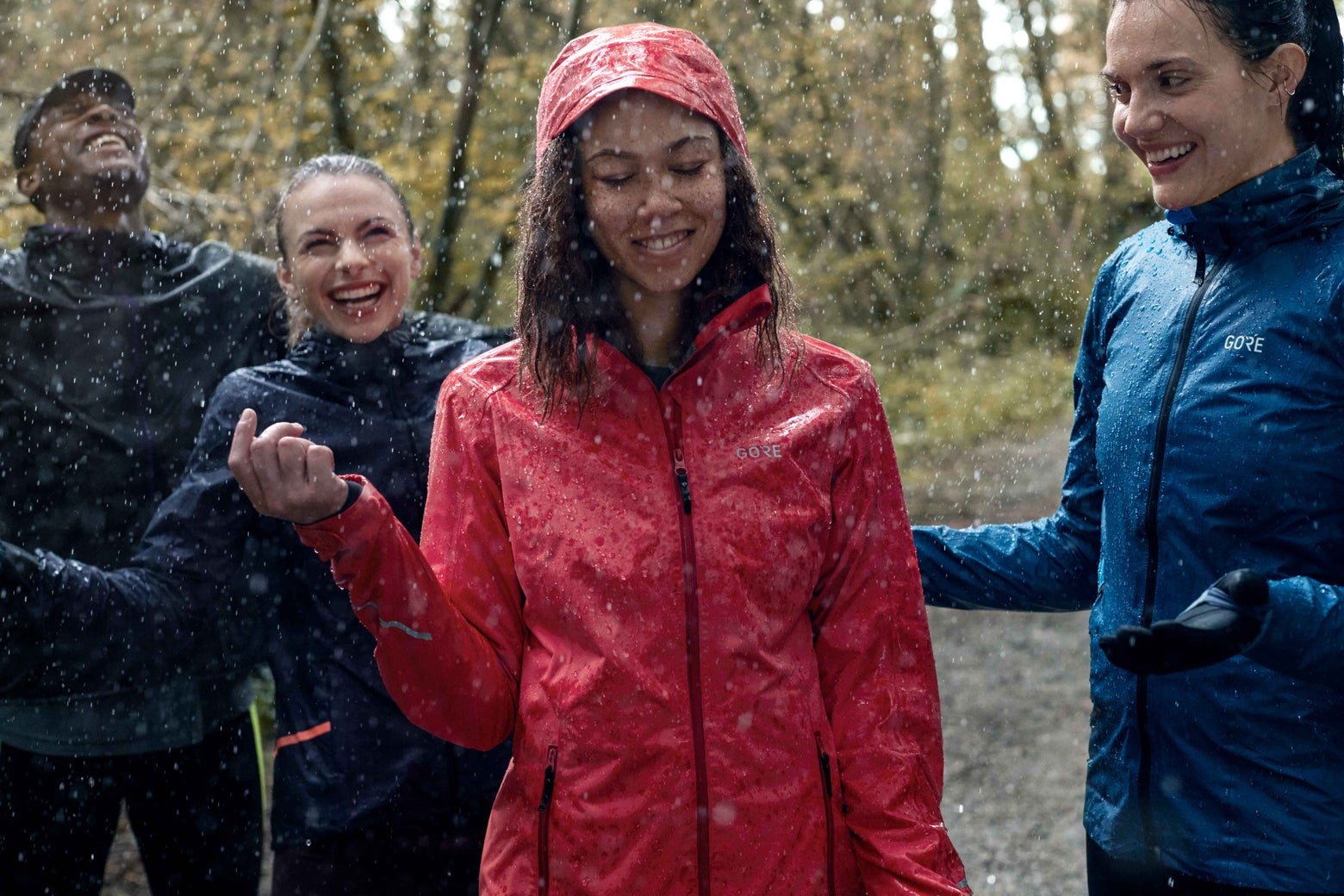Essential Winter Running Tips & Gear
Everything you need to know about getting the best shoes, clothes, and gear for cold-weather running
Updated: September 12, 2024 by Caroline Cross

We've reached that time of year again when the temperatures dip, and we have to swap our short-sleeved tees and split shorts for jackets and tights. The warm and summery days are behind us now, but the crisp and cozy runs are about to begin. Rather than letting the winter months get you down or keep you from running, embrace the cold! Let the burn of the frigid air fill your lungs as you push on through the miles ahead. With the proper clothes and gear, you can stay comfortable and continue to train all season long. So whether you are new to cold-weather running or want to ensure you are well-prepared for the next few months, we've put together a handful of winter running tips along with the best types of running shoes, clothes, and essential gear you will need during this season. We hope this guide helps you find the best winter running gear for your needs so you can confidently tackle those brisk and chilly winter runs head-on.
Tip #1: Choose the Right Shoes

Choose a Shoe With Weather Protection
The first piece of necessary equipment for running in the winter months is a solid pair of shoes that can handle the cold, wind, or rain. Most running shoes feature a breathable mesh upper to prevent your feet from overheating in warmer weather. However, in colder weather, you need an extra layer of protection, which is where weatherproof uppers really come in handy. Technology such as GORE-TEX is used in the uppers of many brands to shield against the rain. Meanwhile, other brands, such as Saucony's RunShield or Altra's All-Weather, offer proprietary water-resistant materials. Regardless of your choice, any weather-resistant upper is a huge plus in keeping your feet protected in inclement weather.
Whether you're getting in a tempo run or embarking on that weekend long run, it's crucial to have footwear that ensures your feet remain dry and comfortable, even in wet or snowy conditions.
Don't Skimp on Grip
Additionally, you want to select a winter-weather shoe with plenty of grip so you're not slipping and sliding around as you take on the miles. While many running shoes offer a rubber outsole for gripping the road, you want to avoid shoes that opt for foam instead of rubber, especially on icy paths. If you will be running on trails or snow-packed roads, a trail shoe with lugs fits the bill. Otherwise, we recommend looking for a shoe with a Vibram outsole or Vibram Arctic Grip designed specifically for slick, frozen terrain and found in the top winter running shoes for snow.
Pay Attention to Fit
Lastly, another major component to be aware of while selecting winter footwear is how the shoe will fit in the cold. Running shoes with a waterproof GORE-TEX liner tend to have a snugger fit due to their extra layer of material and lack of elasticity. It's also important to note that you will most likely be wearing thicker socks to protect your feet from the cold, so it can be helpful to size up a half size from your normal running shoes to accommodate the extra room.
Tip #2: Layer Appropriately for the Weather

How to Layer for Cold-Weather Running
The best method for staying warm and dry during cold-weather runs is to layer your clothes. The layering technique begins with the clothes closest to your skin and then adding layers of clothing, working your way outward to an insulated jacket or a weather-protective shell, depending on conditions. Be careful not to overdress, as your body will warm up as you run, and excessive sweat in the cold can lead to extreme discomfort or hypothermia. A good rule of thumb is to dress for 10 to 15 degrees warmer than the outside temp to account for your body's natural rise in temperature during activity.
Begin layering with either a base layer or a first layer. This layer fits closest to your skin and wicks away moisture as you sweat to avoid chills and hypothermia. For the next layer, also known as the mid-layer, you want to add a vest, fleece, or insulating jacket. This layer is purely for added warmth, especially in chilly temperatures. Lastly, in wet or windy conditions, a weather-resistant outer layer is essential. The material of the outer layer's shell might be thin but it will offer optimal protection from the wind or rain. These jackets are also perfect for changing conditions, where you can quickly shed the outer layer if you get too warm or throw it on if the weather turns sour.
Regardless of the type of layer, you want to avoid cotton-based clothes at all costs, instead opting for performance wool or synthetic fabrics like polyester that can quickly wick sweat. The main reason to stay away from cotton is that it retains moisture and dries slowly, which can lead to chafing or, in frigid conditions, drastically lower your body temperature.
For a more in-depth look into creating a layering system for yourself, check out our Layering for Cold Weather Running guide to get you started.
Don't Get Caught Without Weather Protection
Because the weather can offer a variety of conditions, weather-protective clothes are also spread across a broad spectrum to cover each situation. Weather protection typically comes in two different forms: weather-resistant and weatherproof. Water resistance signals a more moderate form of wind or water protection, equipped to handle light rain, drizzle, or breezy conditions for a shorter time frame. Waterproofing features more substantial details like taped seams and GORE-TEX layers, adding further protection over longer durations.
You will often find these features in running jackets, but don't forget about your legs! There are a lot of high-quality cold-weather running tights that wick sweat, dry quickly, and have protection from the wind and precipitation.
Tip #3: Accessories Are Key for Warmth & Visibility

Keep Your Extremities Warm
Although proper shoes and clothes should be the main priority when you're running in the winter, it's also essential to keep your extremities warm. In cold weather, your hands and feet are the first parts of your body to feel chilled because your body's natural response to the cold is to slow blood flow from your fingers and toes and concentrate it around your vital organs to keep them alive and functioning. Gear such as thick winter socks, gloves, neck warmers, and cold-weather hats and beanies go a long way toward adding warmth and comfort so you can extend your run. Like running clothes, a lot of cold-weather running gear offers weather protection against wind or rain for even more coverage.
Stay Visible in Low Light
Not only are the winter months the coldest time of the year, but they are also the darkest. As such, it's vital for you to easily see the path ahead while being seen by passing motorists. Headlamps and belt lights ensure optimal visibility while running in the dark. These light sources allow hands-free running and help illuminate your path to avoid tripping hazards. While belt lights provide a brighter light overall and a lower angle for better depth perception, headlamps offer versatility, allowing you to turn your head to see what's around you, and their compact size can easily be stowed into a small pocket when not in use. Lastly, we highly recommend wearing clip-on lights or a reflective vest to stay visible while running in dimly lit conditions. These safety vests fit over your running clothes and allow 360-degree visibility, so you are seen from all angles.
Things to Consider When Running in Cold Weather
• Prioritize safety when running in frigid temps. In addition to wearing the appropriate gear, stay in tune with your body and recognize your threshold of how much cold you can comfortably handle. Knowing your limit is essential to avoiding hypothermia and frostbite. Frostbite occurs when your skin and underlying tissues freeze due to restricted blood flow, causing injury. Superficial frostbite affects the outer layer of your skin with numbness and tingling, and if left untreated, leads to deep frostbite, resulting in painful blisters; this can be life-threatening. Hypothermia is a dangerous, life-threatening emergency when your core body temperature drops below 95F (35C). Signs of hypothermia include shivering, slurred speech, slower reaction time, numbness, pale skin, and fatigue. Severe hypothermia leads to a bluish skin color, shallow breathing, weaker pulse, and loss of consciousness. If you or someone else is experiencing any of the above symptoms, immediately go indoors, remove wet clothing, bundle up with a warm blanket, and seek medical help.
• In chilly or windy conditions, consider wearing a balaclava for head, ears, and neck coverage to help minimize heat loss when running. This headwear offers windproof and water-resistant protection while remaining highly breathable. Apply a lip balm to avoid chapped lips and an anti-chafing salve to protect your skin from any irritation.
• Hydrate and drink fluids before, during, and after your run. You may not feel as thirsty running in cold weather compared to the summertime, but it's essential to maintain adequate hydration and replenish lost electrolytes as needed.
• Do a quick warm-up to support your muscles and get the blood flowing before you start running. The warm-up exercise should be brief and not sweat-inducing.
• Shorten your stride. Be mindful of wet and slippery conditions when running in cold weather, such as black ice, and pay attention to your footing. Maintain a comfortable cadence to avoid falling, and always wear the appropriate footwear with a grippy outsole for reliable traction, especially in snowy, icy, or slushy conditions.
• Change immediately out of your wet clothes when your run is complete and into dry clothing to avoid chills.
When Is It Too Cold to Run?
While individual tolerances vary, the general guideline is to avoid running in below-freezing temps (32F / 0C) to minimize the risk of frostbite and hypothermia. It's also important to consider the wind-chill factor or conditions that impact visibility, and always listen to your body. If you start feeling numbness in your extremities, begin shivering, or feel disoriented, cut your run short and warm up indoors. In frigid temps, we recommend ticking off your miles on the treadmill, at an indoor track, or cross-training at the gym.
Time to Gear Up For Your Winter Runs
There's no reason to dread cold-weather running if you take the necessary precautions and have the right tools to keep you comfortable, safe, and warm. From head to toe, get kitted out in the appropriate running gear to stave off the cold and wind and keep you visible and protected. Running in cold weather also offers many benefits, such as a boost in endorphins and helping to avoid Seasonal Affective Disorder (SAD), and it is less taxing on the body than running in hot temps. So go ahead, lace up, enjoy the fresh air, and maintain consistency in your training all year round. You are bound to feel better afterward!









